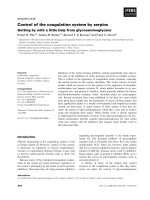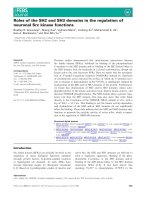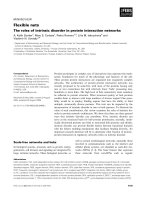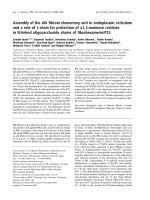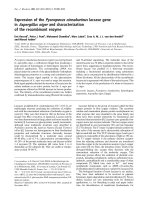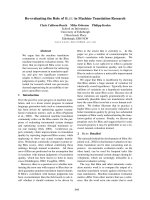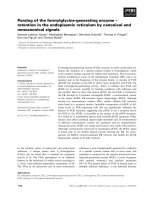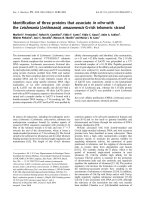Báo cáo khoa học: "Taurolidine reduces the tumor stimulating cytokine interleukin-1beta in patients with resectable gastrointestinal cancer: a multicentre prospective randomized trial" doc
Bạn đang xem bản rút gọn của tài liệu. Xem và tải ngay bản đầy đủ của tài liệu tại đây (448.74 KB, 13 trang )
BioMed Central
Page 1 of 13
(page number not for citation purposes)
World Journal of Surgical Oncology
Open Access
Research
Taurolidine reduces the tumor stimulating cytokine
interleukin-1beta in patients with resectable gastrointestinal
cancer: a multicentre prospective randomized trial
Chris Braumann
1,2
, Carsten N Gutt
3
, Johannes Scheele
4
,
Charalambos Menenakos
1
, Wilhelm Willems
1
, Joachim M Mueller
1
and
Christoph A Jacobi*
1
Address:
1
Department of General, Visceral, Vascular and Thoracic Surgery, Universitaetsmedizin Berlin, Charité Campus Mitte, Humboldt
University, Charitéplatz 1, 10117 Berlin, Germany,
2
Division of Molecular Biology, Universitaetsmedizin Berlin, Charité Campus Mitte,
Humboldt University, Charitéplatz 1, 10117 Berlin, Germany,
3
Department of Surgery, Johann Wolfgang Goethe-University Hospital, Frankfurt
am Main, Germany and
4
Department of General and Visceral Surgery, Friedrich-Schiller-University, Jena, Germany
Email: Chris Braumann - ; Carsten N Gutt - ;
Johannes Scheele - ; Charalambos Menenakos - ;
Wilhelm Willems - ; Joachim M Mueller - ; Christoph A Jacobi* - c.jacobi@krankenhaus-
wesseling.de
* Corresponding author
Abstract
Background: The effect of additional treatment strategies with antineoplastic agents on
intraperitoneal tumor stimulating interleukin levels are unclear. Taurolidine and Povidone-iodine
have been mainly used for abdominal lavage in Germany and Europe.
Methods: In the settings of a multicentre (three University Hospitals) prospective randomized
controlled trial 120 patients were randomly allocated to receive either 0.5% taurolidine/2,500 IU
heparin (TRD) or 0.25% povidone-iodine (control) intraperitoneally for resectable colorectal,
gastric or pancreatic cancers. Due to the fact that IL-1beta (produced by macrophages) is
preoperatively indifferent in various gastrointestinal cancer types our major outcome criterion was
the perioperative (overall) level of IL-1beta in peritoneal fluid.
Results: Cytokine values were significantly lower after TRD lavage for IL-1beta, IL-6, and IL-10.
Perioperative complications did not differ. The median follow-up was 50.0 months. The overall
mortality rate (28 vs. 25, p = 0.36), the cancer-related death rate (17 vs. 19, p = .2), the local
recurrence rate (7 vs. 12, p = .16), the distant metastasis rate (13 vs. 18, p = 0.2) as well as the time
to relapse were not statistically significant different.
Conclusion: Reduced cytokine levels might explain a short term antitumorigenic intraperitoneal
effect of TRD. But, this study analyzed different types of cancer. Therefore, we set up a multicentre
randomized trial in patients undergoing curative colorectal cancer resection.
Trial registration: ISRCTN66478538
Published: 23 March 2009
World Journal of Surgical Oncology 2009, 7:32 doi:10.1186/1477-7819-7-32
Received: 5 October 2008
Accepted: 23 March 2009
This article is available from: />© 2009 Braumann et al; licensee BioMed Central Ltd.
This is an Open Access article distributed under the terms of the Creative Commons Attribution License ( />),
which permits unrestricted use, distribution, and reproduction in any medium, provided the original work is properly cited.
World Journal of Surgical Oncology 2009, 7:32 />Page 2 of 13
(page number not for citation purposes)
Background
Surgery remains the only therapeutic treatment with cure
as a possible outcome for patients with colorectal, gastric
or pancreatic cancer. During resection of gastrointestinal
malignancies tumor cells can be released and spread. This
leads to local recurrence, peritoneal carcinomatosis or dis-
tant metastases with poor prognosis [1,2]. Despite
improvements in surgical techniques and use of recent
chemotherapy agents and radiotherapy protocols, most
patients with gastric or pancreatic cancer ultimately die of
their disease. Therefore intraoperative intraperitoneal lav-
age with antitumorigenic solutions may be a valuable new
strategy for gastrointestinal malignancies.
The antineoplastic substance taurolidine (TRD) has been
proved to suppress intraperitoneal gastrointestinal tumor
growth after laparotomy and laparoscopy in animals [3-
5]. TRD has no relevant side effects on haematopoiesis,
liver or renal function in animals. It induces apoptosis
and inhibits growth of various tumor cell lines in vitro [6-
8]. TRD reduces pancreatic cancer progression [9] as well
as TNF-α and VEGF secretion by gastrointestinal neo-
plasms due to the inhibition of protein biosynthesis in
tumor cells [10]. The substance is found under US Patent
7151099. Another interesting substance, heparin, binds
to extracellular receptors and blocks adhesion of tumor
cells to the peritoneal surface [11]. No relevant side effects
have been described with the concentration we used intra-
operatively. Both substances have been previously used.
Povidone-iodine is a substance commonly used by many
institutions in Germany in peritoneal lavages to prevent
wound infections (and tumor growth) [12]. There are
presently no clinical studies investigating the role of pov-
idone-iodine in tumor growth after tumor resection. In an
toxicity study, more than 0.16% of povidone-iodine was
antitumorigenic in almost all tumor cells tested and
showed severe cytotoxicity in vivo and in vitro [13]. Never-
theless, resorption of povidone-iodine, particularly the
PVP-17-molecule, is still unknown and its metabolism in
the liver seems to be problematic. This substance reduces
local immune response due to damaged peritoneal mac-
rophages and mesothelial cells. It enhances fibrin produc-
tion on the liver surface and induces adhesions [11].
Radical surgical treatment of gastrointestinal cancer can
be potentially improved by the intraperitoneal adminis-
tration of agents such as TRD or povidone-iodine. How-
ever, their impact on cytokine release, toxicity, loco-
regional recurrence, distant metastases, and survival time
remains unclear.
This study aimed to assess these substances when instilled
intraoperatively before and after tumor resection. Intra-
peritoneal and serum levels of different cytokines and
inflammatory markers were evaluated perioperatively.
Morbidity, mortality, follow-up, and survival rates were
consecutively assessed.
Methods
Patients
Inclusion criteria to the multicentre prospective rand-
omized controlled trial were open resection of the colon,
gastric or pancreatic cancer, a physical status classified as
ASA I-III, and histopathological R0-resection. Exclusion
criteria were complete ileus, a physical status classified as
ASA IV, histopathological R1- or R2-resection, unknown
metastases detected intraoperativaly, peritoneal carcino-
matosis, intraabdominal abscess, sepsis or clinical rele-
vant organ failure, and apparent coagulopathy.
The trial was set up on a multicentre level in three univer-
sity hospitals in Germany. Between January 1999 and
August 2001 we included adults undergoing elective con-
ventional colectomies, gastrectomies or pancreatectomies
due to cancer. AJCC/UICC TNM classification and stage
groupings were used.
Patients were admitted to the study in accordance to the
inclusion criteria after receiving detailed information
about the trial orally and in a written form and after hav-
ing given their written consent for the participation in the
study. The study was approved by ethics committee.
Procedures and Monitoring
A local investigator in each centre was responsible for
patient admission to the study. All patients were enrolled
strictly to the protocol. Randomisation was based on the
computer program "RANDOMA" one day before surgery.
The operation team was informed of the intraperitoneal
treatment regime after opening the abdomen. The opera-
tions were performed by three surgeons in each centre
(total of nine), all of them with excellent command of
oncologic surgical principles. Each surgeon operated
patients with all three types of cancer.
The patients were randomized into TRD group (n = 60) or
povidone-iodine group (control group, n = 60). All oper-
ations were performed conventionally. Immediately after
opening the abdomen, 200 ml of Ringer's solution was
instilled into the peritoneal cavity for 2 minutes in both
groups. 30 ml of peritoneal fluid was collected (measure-
ment time T1) to evaluate different cytokine levels (IL-1β,
IL-6, and IL-10). After removal of the residual fluid the
therapeutic substances were administered intraperito-
neally and left for 10 minutes: either 500 ml of 0.5% TRD
solution or 500 ml of Ringer's solution (control group).
Again 30 ml of peritoneal fluid was aspirated and ana-
lyzed (T2). A subsequent tumor resection was then carried
out according to the principles of surgical oncology. 30 ml
of peritoneal fluid was then absorbed (measurement T3).
World Journal of Surgical Oncology 2009, 7:32 />Page 3 of 13
(page number not for citation purposes)
At the end of the operation patients underwent a second
therapeutic peritoneal irrigation for 10 minutes: either
1,500 ml 0.5% TRD with 2,500 IU heparin (TRD group)
or 1,500 ml 0.25% povidone-iodine solution (control
group). Again 30 ml of fluid was removed and analyzed
(T4). Before the incision was closed in layers, either 500
ml of 0.5% TRD with 2,500 IU heparin (TRD group) or
500 ml of Ringer's solution (control group) were instilled.
One drainage was placed in Douglas' space and barred in
all patients. 2 hours (h) and 6 h after the operation 30 ml
of peritoneal fluid were taken from the drainage in order
to measure T5 and T6, respectively (Figure 1). Samples
were any time identical diluted, immediately cooled (4°
Celsius; C), centrifuged, and supernatants were stored (-
25°C). The remaining of the intraperitoneal fluid was col-
lected to determine intraabdominal viable tumor cells (in
T1 and T4). The volume of the removed material was 30
ml in all measurements and standardized aspiration after
insertion of the same quantity either of TRD or Ringer's
solution permitted a balanced aspiration from an equal
dilution in all cases. Central venous blood was also taken
at the same assessment points for the determination of the
cytokine levels. Peri- and postoperative coagulation sta-
tus, and peritoneal and serum cytokine concentrations
(IL-1β, IL-6, and IL-10) were investigated.
Specimen for the measurement of the Interleukins were
collected and preserved as recommended by the manufac-
turer.
Interleukin 1-beta measurement
This kit was especially develeoped for the quantitative
determination of human interleukin 1 beta (IL-1beta)
Immunoassay concentrations in cell culture supernates,
serum, and plasma. The parameters were determined in
duplicates by enzyme linked immunosorbent assay
(ELISA) technique as recommended by the manufacturer
R&D Systems GmbH Wiesbaden-Nordenstadt, Germany
(sensitivity 4.9–2,000 pg/ml, Catalog Number OLB00B).
Cell culture supernate samples may require dilution to
read on the standard curve. If samples are suspected to be
more than 1000 pg/mL, specimens were diluted in Cali-
Schematic diagram illustrating the study protocolFigure 1
Schematic diagram illustrating the study protocol.
World Journal of Surgical Oncology 2009, 7:32 />Page 4 of 13
(page number not for citation purposes)
brator Diluent RD6-10. No samples of IL-1beta required
larger dilutions. Probes were examined as recommended
by the manufacturer.
Interleukin 6 and 8
The Quantikine HS human IL-6 Immunoassay and the IL-
6 Immunoassay were developed for the quantitative deter-
mination of human interleukin concentrations in serum,
plasma (, and urine). Probes were examined as recom-
mended by the manufacturer.
Blood samples were also taken preoperatively and on days
1, 2, 4, and 7 postoperatively for the determination of leu-
kocyte counts, HLA-DR expression, and C-reactive protein
levels in both groups.
Clinical management
Patients were admitted under the care of one visceral con-
sultant surgeon per centre. Preoperatively, patients were
given detailed information of the procedure. All patients
underwent identical bowel preparation one day before
surgery. Patients were allowed to drink fluids up to 4 h
before the operation. Anaesthesiologists were informed of
the details of the study. Before induction of general anaes-
thesia a single dose of antibiotic prophylaxis with cefuro-
xim (1.5 g iv) and metronidazol (500 mg iv) was given. A
urinary catheter was placed transurethrically in all
patients. Clinical decisions about hospital discharge were
made by the treating surgical team and not by the investi-
gators. In case of a colectomy a midline laparotomy was
carried out. For a gastrectomy and pancreatectomy a trans-
verse sub-costal incision of the abdomen was performed.
Postoperative pain was managed by patient-controlled
analgesia devices delivering intravenous morphine.
Therapeutic agents
Abdominal irrigations/dilutions were identical at any
time point.
TRD (Taurolin
®
) was applied in a 0.5% solution (pur-
chased from Geistlich Pharma AG, Wohlhusen, Switzer-
land). At the end of the operation TRD and 2,500 IU
heparin were instilled.
Although it has been clearly demonstrated that Povidone-
iodine (Braunol
®
) should be avoided for abdominal lav-
age, many German clinics use the diluted agent in perito-
nitis/sepsis and after colonic or rectal tumor resection. It
was purchased from B. Braun Melsungen AG (Melsungen,
Germany) and was applied intraperitoneally in a 0.25%
solution.
Postoperative course
Patient follow-up was carried out according to a standard-
ized protocol. After hospital treatment, all the patients
were followed-up on an outpatients' basis. Postopera-
tively, patients were thoroughly examined on the 1, 2, and
3 months, and every 3 months thereafter. Follow-up
included physical examination, blood counts and bio-
chemistry, ultrasound of the abdomen, and in suspicion
of relapse, abdominal CT-scan. Pulmonary metastases
were detected with thoracic X-ray or thoracic CT-scan.
Results of a median follow-up of 50.0 months (range 1.7–
72.6) are currently reported.
Ethical and Human Considerations
The Ethics Committee of the Charité Campus Mitte, Uni-
versity Hospital, Universitaetsmedizin Berlin, Germany,
was the leading study centre and approved the study
design. The study was carried out in accord with the ethi-
cal standards of the Helsinki declaration of 1975. Written
informed consent was obtained from all patients before
enrolment. The study has been registered in the Interna-
tional Standard Randomized Controlled Trial Number
Register (ISRCTN66478538).
Sample size, power calculation, and statistical analysis
The main endpoint of the study was the determination of
the perioperative concentration of IL-1β in the patient's
peritoneal fluid. On the basis of Badia et al. [14] we
assumed that the intraperitoneal concentration of IL-1β
(190.6 ± 90 pg/ml) eight hours after a pancreas operation
is at least 30% lower in the taurolidine group compared to
the povidone-iodine group. For a 0.05 difference with a
power of 80% every group included 60 patients. We also
assessed other long-term values: probability of overall sur-
vival and of being free of recurrence. Because of the objec-
tive of the study patients with metastatic disease were
excluded. Time to metastasize, local recurrence or death
was calculated from surgical resection to the last visit, call
or death. For cancer-related survival, patients who died
from other causes were evaluated at time of death. Sur-
vival, metastases, and recurrence rates were calculated
with the Kaplan-Meier method and differences were
tested by log-rank test. Categorical variables were com-
pared by chi-squared test (Fisher's exact test). Continuous
variables were evaluated by the Student-t-test or Mann-
Whitney-U-test, depending on the distribution. Results
were considered significant if the two-sided p values were
0.05 or less. Tests were performed with the statistical soft-
ware SPSS 14.0 for Windows. An independent data mon-
itoring committee was appointed to review all data.
Results
From the 158 patients assessed for eligibility for the study,
38 were excluded. Patients enrolled in the study included
for TRD: Berlin n = 25, Frankfurt n = 18, Jena n = 17, and
for povidone-iodine: Berlin n = 24, Frankfurt n = 18, and
Jena n = 18. Figure 2 shows the trial profile. 120 patients
took part in the study, with 60 patients in each group. The
World Journal of Surgical Oncology 2009, 7:32 />Page 5 of 13
(page number not for citation purposes)
first operation was performed in February 2001 (follow-
up 72 months) and the last organ resection was per-
formed in August 2003 (42 months), so that the follow-
up for all patients was at the end of 2007. The data were
interpreted and the statistical analysis was performed in
2008. Detailed characteristics of patients including demo-
graphic profiles, ASA classification, co-morbidities, and
the type of operation performed did not differ between
the groups and are listed in Table 1. Types and sites of dis-
ease including the Union International Contre Le Cancer
classifications (UICC) are also listed in Table 1.
Risk factors, particularly diabetes mellitus, were higher in
the TRD group (Table 1).
We were interested in the effects of the used intraoperative
irrigation fluid on morbidity, mortality rates, as well as on
perioperative complications. Therefore, the overall rates
are shown in Table 2. In intraperitoneal samples IL-1β val-
ues were lower in the TRD group (shown in Figure 3; T3
measurement p = 0.029, T5 p < 0.001, T6 p < 0.001). Sim-
ilar data were obtained with IL-6 (shown in Table 3a; T3
p = 0.048, T4 p = 0.017, T5 p = 0.003, and T6 p = 0.008),
and with IL-10 (in T5, p < 0.001 and T6, p < 0.001). There
was no statistically significant difference between other
Interleukin values in both groups in the intraperitoneal
fluid. No viable tumor cells were detected in T1–T3 situa-
tions. T4 sample cytology was positive for malignant cells
in only one patient from each group.
In serum samples IL-1β was not detectable (Table 3). IL-6
levels were lower in the TRD group (T5 p = 0.012, T6 p =
0.009) and serum IL-10 of the TRD group was lower in T1
(p = 0.026). Monocyte HLA-DR level suppression was
analyzed on postoperative day 2 (Table 4; p < 0.05). No
statistically significant differences were observed in the
CRP values.
Patients with clinical relevant peritonitis were treated on
ICU whereas patients with subcutaneous wound infec-
tions were discharged. The mortality rate at 30 days post-
operative was 3.3% (2 patients) and 5% (3 patients) in
the TRD group and in the control group, respectively. The
difference was statistically insignificant. The median
length of follow-up is shown in Table 5. The focus of this
study was not the use of the agents in a special tumor type-
we paid attention on the effects of macrophage-produced
IL-1 beta in different gastrointestinal tumors. After sur-
gery, 14 patients of the TRD group (23%) and 21 patients
of the control group (33%) received adjuvant chemother-
apy and radiotherapy (9 vs. 7) according to the estab-
lished protocol. Although less patients in the TRD group
received chemotherapy, especially with gastric cancer (p =
0.02), no effects on overall tumor recurrence rate were
detected (p = 0.35), neither in time to recurrence (p =
0.59) nor time to metastasis (p = 0.24). The loco-regional
recurrence rate (p = 0.16), the rate of distant metastases (p
= 0.2), and the cancer-related mortality did not differ
between the groups (Table 4). Data on probability of stay-
ing free of relapse are not shown.
Follow-up studies
All enrolled patients were followed-up postoperatively
according to a standardized postoperative surveillance
protocol. Patients receiving adjuvant chemotherapy in the
TRD group did not differ from the control group with the
exception of patients with gastric cancer (Table 5). The
loco-regional recurrence rate and the distant metastasis
rate were both minimal lower (but not statistically signif-
icant) in the TRD group as compared to the control group-
despite the fact that much more patients with gastric can-
cer in the control group (n = 7) had received chemother-
apy vs. 1 patient in TRD group (Figure 4a and 4b). Similar
differences were observed in the time to local recurrences,
with patients in TRD group showing distant metastatic
diseases at a slightly later time point than the control
group. Finally the overall mortality rate was similar in
both groups. The overall survival rate and the total dis-
ease-free time are shown in figure 5.
Discussion
Although extensively investigated over the previous years,
the exact mechanisms of local or distant metastatic tumor
growth, even after a R0 tumor resection, remain unclear.
Cytokines produced by cells of the immune system and
other relevant tissues act as mediators of immune reac-
tions. IL-1β, IL-6, and IL-10 responses have been exhaus-
tively investigated, particularly in their connection with
tumor growth and metastatic spread in colon cancer resec-
tion [15]. Of particular interest in this setting is IL-1, a
pleiotropic cytokine with numerous roles in both physio-
logical and pathological states which is primarily pro-
duced by intraperitoneal macrophages (and not by the
tumor cells). This mediator seems to be a precious indica-
tive factor for perioperative intraabdominal tumor growth
stimulation independent of the tumor type. Therefore, the
IL-1beta level of gastric, colonic and pancreatic tumors
was determined. It is known to be up regulated in many
tumor types and has been implicated as a factor in tumor
progression via the expression of metastatic and ang-
iogenic genes and growth factors. IL-1 is mainly produced
by intraabdominal macrophages in immunoactive tis-
sues. It is a pluripotent cytokine responsible for normal
physiological roles ranging from the induction of vascular
permeability and fever during sepsis to the increased
secretion of additional cytokines in autoimmune diseases.
Therefore, an important balance exists between the bene-
ficial and harmful effects of IL-1. Cancer cells directly pro-
duce IL-1 or can induce cells within the tumor
microenvironment to do so; studies have documented
World Journal of Surgical Oncology 2009, 7:32 />Page 6 of 13
(page number not for citation purposes)
Table 1: Patient's baseline and clinical characteristics
Taurolidine group
n = 60
Control group n = 60 p
Age (years) 66.9 (26.4–87.1) 64.5 (22.8–80.8) 0.08
Sex (male/female) 37 (61.7%)/23 (38.3%) 35 (58.3%)/25 (41.7%) -
Height 170 (7.7) 171 (8.8) 0.76
Weight 74.2 (13.7) 74.2 (11.8) 0.92
Type of cancer n = 60 n = 60
Colon 48.3% 29 46.7% 28
Gastric 43.3% 26 43.3% 26
Pancreatic 8.3% 5 10% 6
UICC histopathological staging
Colon cancer 29 28
I 89
II 89
III 13 10
Gastric cancer 26 26
IA 45
IB 67
II 85
IIIA 56
IIIB 33
Pancreatic cancer 5 6
I 2
II 22
III 32
ASA classification (all patients)
I 23.3% 14 23.3% 14
II 38.3% 23 38.3% 23
III 38.3% 23 38.3% 23
Risk factors 32 24
Arterial hypertension 33.3% 20 26.6% 16
Chronic obstructive lung disease 1.6% 1 5% 3
Diabetes mellitus 13.3% 8 6.6% 4
Nephropathy 5% 3 1.6% 1
Tumour location
Colon:
Caecum 1
Ascending colon 5 3
Transverse colon 3 6
Descending colon 2 3
Sigmoid colon 55
Rectum 14 10
Stomach:
Gastric cardia 53
Gastric fundus 46
Gastric body 69
Gastric antrum 11 8
Pancreas:
Pancreatic head 56
Intervention
World Journal of Surgical Oncology 2009, 7:32 />Page 7 of 13
(page number not for citation purposes)
constitutive IL-1alpha protein production in human and
animal cancer cell lines including sarcomas and ovarian
and transitional cell carcinomas. The exact mechanisms
by which IL-1 promotes tumor growth remain unclear,
though the protein is believed to act primarily indirectly.
IL-1 induces expression of metastatic genes such as matrix
metalloproteinases (MMP) and stimulates nearby cells to
produce angiogenicproteins and growth factors such as
VEGF, IL-8, IL-6, TNFalpha, and tumor growth factor beta
(TGFalpha) [16]. Recent studies have determined the
necessity of IL-1 in tumor growth, metastasis, and angio-
genesis [17]. The ability of IL-1 to induce the expression of
angiogenic factors such as VEGF and IL-8 is believed to
promote tumor growth and metastasis. These studies
highlighted the importance of IL-1 alpha in cell adhesion
and invasion into extracellular matrix proteins, and stud-
Right colectomy 4 4
Extended right colectomy 2 1
Left colectomy 26
Extended left colectomy 1 2
Sigmoidectomy 54
Rectum resection 10 9
Abdominoperineal resection 4 1
Subtotal colectomy 1 1
Total gastrectomy 14 19
Total gastrectomy + splenectomy 3 2
Subtotal (3/4) gastrectomy 8 5
Distal esophageal resection 1
Pancreatic head resection (Kausch-Whipple' resection) 1 3
Pylorus-preserving duodenopancreatectomy 4 3
Values are median (range), mean (standard deviation) or number, esophagectomy: adenocarcinoma of the cardia (Type Siewert I)
Table 1: Patient's baseline and clinical characteristics (Continued)
Trial profileFigure 2
Trial profile.
World Journal of Surgical Oncology 2009, 7:32 />Page 8 of 13
(page number not for citation purposes)
ies by Voronov et al. complement findings regarding the
importance of IL-1 in metastasis. They demonstrated that
IL-1alpha/IL-1 knockout mice failed to develop solid
tumors following injection of melanoma cells and exhib-
ited significantly improved survival compared to the wild-
type animals, which died due to lung metastases.
Meanwhile previous studies confirmed a significant asso-
ciation between the IL-1 polymorphisms and increased
risk for tumor development in patients with intestinal
type or diffuse gastric carcinoma with an odds ratio of 2.7
for carriers of IL-1 (gene 1B-511T) [18]. Barber et al. found
that patients with pancreatic cancer who were
homozygous for allele 2 of the IL-1 gene had significantly
shorter survival rates than other groups associated with a
higher CRP level [19].
The above-mentioned results on the basic influence of IL-
1β on carcinogenesis do support our main end-point and
demonstrate the importance of our observations concern-
ing the significant inhibition of IL-1β production in
patients with colon, gastric, and pancreatic malignancies
treated with taurolidine. These results highlight the poten-
tial anti-tumor effects of TRD through a cytokine modu-
lating effect. The major outcome criterion of our study was
the influence of TRD and povidone-iodine administration
on the pro-inflammatory cytokine IL-1β. Although it has
been demonstrated that Povidone-iodine has to be
avoided for peritoneal irrigation in peritonitis and during
colonic/rectal resection, it is still in use in many german
and european hospitals. This substance has been shown
to be an irritant and to damage macrophages, and it is no
longer used as a peritoneal irrigant in the vast majority of
operations. But, this study was performed 7 years ago.
Although we did notice a reduction of intraperitoneal IL-
1β production after identical dilution of intraperitoneal
fluid compared to PVP-iodine in the TRD group (p <
0.001), the overall disease-free time and the survival rate
between the two groups were not significant. The differ-
ences in cytokine levels in peritoneal fluid are different. It
is very difficult for us to explain the findings and what that
means for cancer disease. Previous studies were able to
detect IL-1β in the serum [20], however, in our assays we
did not. This could be attributed to the lower sensitivity of
the kit used. In our study the serum blood counts (leuko-
cytes) and the CRP value have not been affected by TRD.
The immunological status of the patients was evaluated
from the monocyte HLA-DR status. Significantly higher
values were detected on the first and second postoperative
day in the TRD-group vs. povidone-iodine. This result
Table 2: Data related to surgical intervention
Taurolidine group
(n = 60)
Control group
(n = 60)
p
Duration of intervention (min)
Colon 206 (74) 191 (53) 0.39
Stomach 259 (57) 272 (102) 0.57
Pancreas 318 (58) 371 (163) 0.51
Perioperative mortality rate 2 3 0.5
Colon 10.5
Stomach 2 1 0.5
Pancreas 10.5
Perioperative morbidity rate 17 20 0.35
Colon 8 6 0.54
Stomach 8 9 0.5
Pancreas 3 0.12
Surgery-related complications 11 13 0.41
Anastomotic leak 6 6 -
Peritonitis 5 3 0.36
Intraperitoneal hemorrhage 1 -
Subcutaneous wound infection 5 11 0.08
Non-surgery complications 12 13 0.5
Myocardial infarction 1 2 0.5
Transient cardiac arrhythmia 4 6 0.37
Pneumonia/pleural effusion 9 10 0.5
Acute renal failure 1 3 0.31
Hepatic decompensation 10.5
Data are mean (SD), median* (range) or number of patients; 30 days mortaility- and complication rate: chi-squared test (Fisher's exact)
World Journal of Surgical Oncology 2009, 7:32 />Page 9 of 13
(page number not for citation purposes)
could be interpreted as an increased immune response to
TRD stimulation after surgery. Similar immunostimulant
effects of TRD have been reported by other authors [21].
The fate of local tumor cell spread at the time of resection
and whether it reaches the systemic circulation depends
on the immunological status, the biologic behaviour of
the neoplasm, and the number of the cells. In our study,
intraperitoneal fluid cytology revealed no tumor cells
immediately after the abdominal cavity was entered, but
it was positive in one patient (out of 60) per group after
tumor resection. These data are consistent with other
observations [22] when resection is strictly performed
according to oncological and surgical principles in cura-
tive cancer. It is known that tumor cell spillage can lead to
loco-regional recurrences. Therefore, the instillation with
an antitumorigenic substance like TRD is an alternative
option for a complimentary perioperative treatment.
In our study of the colon cancer group, the median of the
time to metastasis was 23.7 and 19.3 months in the TRD
and the control group, respectively (p = 0.28). The overall
survival was 35.5 months in the TRD group and 22.1
months in the control group (p = 0.34). Although not sta-
tistically significant, survival seems to be slightly better in
the TRD group despite the fact that this group included
patients with a higher tumor stage (UICC) and more
comorbidities (in ASA scale) than the control group. A lit-
erature-based meta-analysis from the American Society of
Clinical Oncology found no evidence for statistically sig-
nificant survival benefit of adjuvant chemotherapy for
stage I/II patients [23]. In our series there were no differ-
ences in the usage of adjuvant chemotherapy in patients
with colon cancer.
The Dutch trial and the British Medical Research Cancer
trial are two large prospective randomized studies evaluat-
ing the D1 versus D2 extended gastric cancer resection and
lymphadenectomy [24,25]. No study showed a benefit for
the D2-resection. The standard procedure performed in
our participating centres was a D1-resection. Although a
beneficial effect of adjuvant therapy after R0 resection is
currently controversial [26,27], one patient in the TRD
group and seven patients in the control group received
chemotherapy (p = 0.02). This could be due to a slightly
higher tumor stage in the control group. Adjuvant radio-
therapy is a rare option and was only performed in UICC
IIIa and UICC II in the TRD group and control group,
respectively. The median of the time to metastasis was
16.5 and 14 months in the TRD and the control group,
Table 3: Cytokine levels of peritoneal fluid and serum (pg/ml); tumor cell detection; taurolidine group (TRD); povidone-iodine group
(C).
T1 T2 T3 T4 T5 T6
Peritoneal
fluid
TRD C TRD C TRD C TRD C TRD C TRD C
IL-1β *4.9
(4.9–4.9)
4.9
(4.9–6.2)
4.9
(4.9–4.9)
4.9
(4.9–9.7)
4.9
(4.9–58.4)
7.5
(4.9–129)
4.9
(4.9–41.8)
4.9
(4.9–54.0)
15.0
(4.9–441)
36.6
(4.9–561)
31.1
(4.9–
1410)
68.8
(6.3–
1001)
IL-6 * 4.9
(4.9–325)
4.9
(4.9–216)
4.9
(4.9–197)
4.9
(4.9–568)
429
(4.9–
5350)
738
(4.9–10000)
261
(4.9–
6580)
455
(4.9–
20000)
4530
(26–
10000)
5001
(273–
20000)
5001
(7–10000)
5700
(1001–
20000)
IL-10 * 1.6
(0.8–50.5)
1.7
(1.0–21.3)
1.6
(0.8–36.2)
1.6
(0.9–13.7)
5.6
(0.8–81.4)
9.0
(1.6–98.8)
4.1
(1.1–31.4)
4.0
(1.6–87.6)
27.2
(0.8–100)
61.5
(3.0–250)
39.2
(1.6–155)
88.8
(4.0–250)
Tumour
cells
00 1
(1.7%)
1
(1.7%)
Serum
IL-1β
IL-6 * 4.9
(4.9–17.0)
4.9
(4.9–29.8)
4.9
(4.9–49.8)
4.9
(4.9–83.8)
43.0
(4.9–326)
42.6
(4.9–302)
43.5
(4.9–288)
44.3
(4.9–553)
87.7
(11–1500)
138
(10–650)
83
(4.9–
1480)
165
(13–3460)
IL-10 * 1.6
(0.8–25.0)
1.7
(0.8–38.8)
1.6
(0.8–25.0)
1.6
(0.8–38.8)
4.7
(1.6–100)
6.1
(0.8–108)
4.6
(1.6–77)
7.9
(1.6–135)
6.5
(1.6–85)
9.1
(1.5–248)
7.0
(1.6–50.0)
6.9
(1.6–223)
Values are given as mean (SD), t-test or median* (range), Mann-Whitney-U-test; statistical significance is shown in bold letters
World Journal of Surgical Oncology 2009, 7:32 />Page 10 of 13
(page number not for citation purposes)
respectively (p = 0.76). The overall survival was 12.8 and
12.4 months in both groups (p = 0.65). Although not sta-
tistically significant, survival seems to be slightly better in
the TRD group.
Curative resection for pancreatic cancer is possible in only
10% to 15% of cases [28], with an overall 5-year survival
of 15% to 21% in most studies. In our study two patients
in the TRD group (UICC stage II and III) and four patients
in the control group (one patient UICC stage I, two
patient UICC II, and one patient UICC III) received adju-
vant chemotherapy. Although overall prognosis depends
on clinicopathological staging, tumor biological features
and molecular genetics, the local recurrence and metasta-
sis rate did not differ between our groups, with the time to
metastasize slightly longer in the TRD group. The median
of the time to metastasis was 22.3 and 12.3 months in the
TRD and the control groups, respectively (p = 0.23). The
overall survival was 15.6 and 10.5 months in both groups
(p = 0.66).
Povidone-iodine lavage is commonly used abdominal
disinfectant. In our study the subcutaneous wound infec-
tion rate was higher in the povidone-iodine group com-
pared to the TRD group. These findings are consistent
with other results showing no benefit in povidone-iodine
use for prevention of wound infection [29].
Conclusion
In summary the basic aspects of TRD in patients with gas-
trointestinal cancer are as follows: The agent seems to be
a strong local inhibitor of IL-1β, although its clinical influ-
ence is still unclear. TRD does not substitute surgical resec-
tion. It should be rather seen as an additional mean
against metastatic tumor growth following the resection
of the primary solid tumor. The interpretation of these
results in terms of the antitumorigenic effects are currently
being investigated in a larger German multicentre clinical
prospective randomized controlled trial.
Competing interests
Christoph A. Jacobi and Chris Braumann received support
from Hoechst Marion Roussel, Germany. The company
markets the agent Taurolin
®
used as an antimicrobial sub-
stance in Germany. Rest of the authors have no competing
interest to declare.
Authors' contributions
CB designed the protocol, monitored the patients, col-
lected, analysed and interpreted the data, and wrote the
manuscript. CNG and JS recruited the patients and coor-
dinated the study in the other two surgical centres. CM
and WW monitored the patients and collected the data in
the study coordinating center Berlin. JMM contributed to
the idea and supported the study. CAJ contributed to the
idea, designed the protocol, conceived and coordinated
the study, enrolled the patients, gathered the data, ana-
Perioperative IL-1β levels of the peritoneal fluidFigure 3
Perioperative IL-1β levels of the peritoneal fluid.
Table 4: Biochemistry
Preop Postop day 1 Day 2 Day 4 Day 7
Blood parameters TRD C TRD C TRD C TRD C TRD C
Leukocytes (/μl) 7.2 (2.4) 6.6 (2.6) 10.4 (3.2) 10.9 (4.1) 10.9 (3.7) 11.2 (3.2) 8.2 (2.6) 8.5 (3.3) 9.7 (3.3) 10.2 (5.0)
HLA-DR4
(monocyte expression)
32.3 31.5 38.1 30.5 46.1 28.6 37.5 34.9 49.1 51.2
CRP (mg/dl) 1.5 (3.0) 1.0 (2.1) 8.4 (3.9) 8.5 (3.7) 13.2 (6.8) 13.6 (5.5) 10.0 (8.2) 9.5 (6.4) 8.3 (7.7) 7.2 (6.8)
Values are given as mean (SD), t-test or median* (range) in pg/ml, Mann-Whitney-U-test; statistical significance is shown in bold letters
World Journal of Surgical Oncology 2009, 7:32 />Page 11 of 13
(page number not for citation purposes)
Table 5: Tumor recurrence and mortality
Taurolidine group
(n = 60)
Control group
(n = 60)
P
Adjuvant chemotherapy 14 21 .11
Colon cancer 11 10 -
Gastric cancer 170.02
Pancreatic cancer 24-
Adjuvant radiotherapy 9 7 0.39
Colon cancer 76-
Gastric cancer 21-
Pancreatic cancer
Follow-up* (months) 50.0 (1.7–72.0)
Colon cancer 53.5 (9.0–72.1) 59.2 (19.6–72.0) 0.41
Gastric cancer 39.9 (1.7–72.0) 43.7 (5.7–67.3) 0.84
Pancreatic cancer 15.6 (8.5–34.5) 10.7 (8.8–46.9) 0.66
Overall tumour recurrence rate 19 22 0.35
Type of recurrence
Loco-regional recurrence rate 7 12 0.16
Colon cancer 240.32
Gastric cancer 350.35
Pancreatic cancer 2 3 0.61
Time to local recurrence* (months) 17.8 (5.6–35.6) 16.0 (5.3–26.5) 0.43
Colon cancer 10.9 and 35.6 18.4 (6.0) 1
Gastric cancer 18.2 (2.9) 14.9 (4.4) 0.39
Pancreatic cancer 5.6 and 21.3 10.8 (7.0) 0.8
Distant metastasis rate 13 18 0.2
Colon cancer 680.35
Gastric cancer 460.36
Pancreatic cancer 3 4 0.65
Time to metastasis * (months) 21.0 (5.2–44.5) 14.4 (3.0–35.9) 0.17
Colon cancer 23.7 (11.4–44.5) 19.3 (3.0–35.9) 0.28
Gastric cancer 16.5 (5.2–34.1) 14.0 (5.9–24.1) 0.76
Pancreatic cancer 22.3 (12.3–24.0) 12.3 (4.0–18.6) 0.23
Overall mortality rate 28 25 0.36
Colon cancer 870.53
Gastric cancer 15 12 0.29
Pancreatic cancer 5 6 -
Time to death * (months) 20.0 (0.1–61.0) 19.6 (0.1–58.5) 0.71
Colon cancer 35.6 (9.0–61.0) 22.1 (0.1–58.5) 0.34
Gastric cancer 12.8 (0.1–58.6) 12.4 (0.8–40.1) 0.65
Pancreatic cancer 15.6 (8.5–34.5) 10.5 (0.8–46.9) 0.66
Causes of death
Cancer-related mortality rate 17 19 0.2
Colon cancer 66-
Gastric cancer 680.22
Pancreatic cancer 5 5 -
Perioperative mortality 2 3 0.5
Others 93
Tumour progression 15 16
Data are mean (SD), median* (range) or number of patients, t-test, chi-squared test (fisher's exact test), for unequal distribution Mann-Whitney U test, and for Kaplan-Meier
method Log Rank test were used; perioperative mortality (30 days) TRD group: stomach – myocardial infarction died on postop day 4 (n = 1), stomach – multiorganic failure
died on postop day 14 (n = 1); Control group: pancreas – anastomotic leak, multiorganic failure died on day 23 (n = 1), colon – pulmonal embolism died on day 2 (n = 1),
stomach – pneumonia died on day 23 (n = 1); follow-up: time to last examination or death
World Journal of Surgical Oncology 2009, 7:32 />Page 12 of 13
(page number not for citation purposes)
lysed the data and reviewed the manuscript. CAJ and CB
are guarantors of the report. All authors read and
approved the manuscript.
Acknowledgements
We thank Professor Dr. J. M. Mueller, the Director of the Department of
Surgery, for his continuous support. Vladimir Atanassov collected the fol-
low-up data. Additional support for laboratory work was provided by Dr.
Ziemer, Biochemistry Department, Charité – Universitaetsmedizin Berlin,
Campus Mitte. We also thank S. Rogalla for his assistance.
References
1. Sugarbaker PH, Mora JT, Carmignani P, Stuart OA, Yoo D: Update
on chemotherapeutic agents utilized for perioperative intra-
peritoneal chemotherapy. Oncologist 2005, 10:112-122.
2. Diaz-Rubio E: New chemotherapeutic advances in pancreatic,
colorectal, and gastric cancers. Oncologist 2004, 9:282-294.
3. Jacobi CA, Wildbrett P, Volk T, Muller JM: Influence of different
gases and intraperitoneal instillation of antiadherent or cyto-
toxic agents on peritoneal tumor cell growth and implanta-
tion with laparoscopic surgery in a rat model. Surg Endosc
1999, 13:1021-1025.
4. Braumann C, Ordemann J, Kilian M, Wenger FA, Jacobi CA: Local
and systemic chemotherapy with taurolidine and taurolid-
ine/heparin in colon cancer-bearing rats undergoing laparot-
omy. Clin Exp Metastasis 2003, 20:387-394.
5. McCourt M, Wang JH, Sookhai S, Redmond HP: Taurolidine inhib-
its tumor cell growth in vitro and in vivo. Ann Surg Oncol 2000,
7:685-691.
6. Calabresi P, Goulette FA, Darnowski JW: Taurolidine: cytotoxic
and mechanistic evaluation of a novel antineoplastic agent.
Cancer Res 2001, 61:6816-6821.
7. Han Z, Ribbizi I, Pantazis P, Wyche J, Darnowski J, Calabresi P: The
antibacterial drug taurolidine induces apoptosis by a mito-
Overall survivalFigure 5
Overall survival.
Survival A)Overall local recurrence free rate b) Overall metastases free rateFigure 4
Survival A)Overall local recurrence free rate b) Overall metastases free rate.
Publish with BioMed Central and every
scientist can read your work free of charge
"BioMed Central will be the most significant development for
disseminating the results of biomedical research in our lifetime."
Sir Paul Nurse, Cancer Research UK
Your research papers will be:
available free of charge to the entire biomedical community
peer reviewed and published immediately upon acceptance
cited in PubMed and archived on PubMed Central
yours — you keep the copyright
Submit your manuscript here:
/>BioMedcentral
World Journal of Surgical Oncology 2009, 7:32 />Page 13 of 13
(page number not for citation purposes)
chondrial cytochrome c-dependent mechanism. Anticancer
Res 2002, 22:1959-1964.
8. Stendel R, Stoltenburg-Didinger G, Al Keikh CL, Wattrodt M, Brock
M: The effect of taurolidine on brain tumor cells. Anticancer Res
2002, 22:809-814.
9. Wenger FA, Kilian M, Braumann C, Neumann A, Ridders J, Peter FJ,
Guski H, Jacobi CA: Effects of taurolidine and octreotide on
port site and liver metastasis after laparoscopy in an animal
model of pancreatic cancer. Clin Exp Metastasis 2002,
19:169-173.
10. Braumann C, Henke W, Jacobi CA, Dubiel W: The tumor-suppres-
sive reagent taurolidine is an inhibitor of protein biosynthe-
sis. Int J Cancer 2004, 112:225-230.
11. Jacobi CA, Peter FJ, Wenger FA, Ordemann J, Muller JM: New ther-
apeutic strategies to avoid intra- and extraperitoneal metas-
tases during laparoscopy: results of a tumor model in the rat.
Dig Surg 1999, 16:393-399.
12. Galland RB, Saunders JH, Mosley JG, Darrell JH: Prevention of
wound infection in abdominal operations by peroperative
antibiotics or povidone-iodine. A controlled trial. Lancet 1977,
19;2:1043-1045.
13. Tsunoda A, Shibusawa M, Tsunoda Y, Choh H, Takata M, Kusano M:
Implantation on the suture material and efficacy of povi-
done-iodine solution. Eur Surg Res 1997, 29:473-480.
14. Badia JM, Whawell SA, Scott-Coombes DM, Abel PD, Williamson RC,
Thompson JN: Peritoneal and systemic cytokine response to
laparotomy. Br J Surg 1996, 83:347-348.
15. Leung KL, Lai PB, Ho RL, Meng WC, Yiu RY, Lee JF, Lau WY: Sys-
temic cytokine response after laparoscopic-assisted resec-
tion of rectosigmoid carcinoma: A prospective randomized
trial. Ann Surg 2000, 231:506-511.
16. Dinarello CA: Biologic basis for interleukin-1 in disease. Blood
1996, 87:2095-2147.
17. Voronov E, Shouval DS, Krelin Y, Cagnano E, Benharroch D, Iwakura
Y, Dinarello CA, Apte RN: IL-1 is required for tumor invasive-
ness and angiogenesis. Proc Natl Acad Sci USA 2003,
100:2645-2650.
18. Machado JC, Pharoah P, Sousa S, Carvalho R, Oliveira C, Figueiredo
C, Amorim A, Seruca R, Caldas C, Carneiro F, et al.: Interleukin 1B
and interleukin 1RN polymorphisms are associated with
increased risk of gastric carcinoma. Gastroenterology 2001,
121:823-829.
19. Barber MD, Powell JJ, Lynch SF, Fearon KC, Ross JA: A polymor-
phism of the interleukin-1 beta gene influences survival in
pancreatic cancer. Br J Cancer 2000, 83:1443-1447.
20. Leung KL, Lai PB, Ho RL, Meng WC, Yiu RY, Lee JF, Lau WY: Sys-
temic cytokine response after laparoscopic-assisted resec-
tion of rectosigmoid carcinoma: A prospective randomized
trial. Ann Surg 2000, 231:506-511.
21. Da Costa ML, Redmond HP, Bouchier-Hayes DJ: Taurolidine
improves survival by abrogating the accelerated develop-
ment and proliferation of solid tumors and development of
organ metastases from circulating tumor cells released fol-
lowing surgery. J Surg Res 2001, 101:111-119.
22. Kim SH, Milsom JW, Gramlich TL, Toddy SM, Shore GI, Okuda J,
Fazio VW: Does laparoscopic vs. conventional surgery
increase exfoliated cancer cells in the peritoneal cavity dur-
ing resection of colorectal cancer? Dis Colon Rectum 1998,
41:971-978.
23. Edwards BK, Brown ML, Wingo PA, Howe HL, Ward E, Ries LA,
Schrag D, Jamison PM, Jemal A, Wu XC, et al.: Annual report to the
nation on the status of cancer, 1975–2002, featuring popula-
tion-based trends in cancer treatment. J Natl Cancer Inst 2005,
97:1407-1427.
24. Cuschieri A, Fayers P, Fielding J, Craven J, Bancewicz J, Joypaul V,
Cook P: Postoperative morbidity and mortality after D1 and
D2 resections for gastric cancer: preliminary results of the
MRC randomised controlled surgical trial. The Surgical
Cooperative Group. Lancet 1996, 347:995-999.
25. Bonenkamp JJ, Songun I, Hermans J, Sasako M, Welvaart K, Plukker
JT, van Elk P, Obertop H, Gouma DJ, Taat CW, et al.: Randomised
comparison of morbidity after D1 and D2 dissection for gas-
tric cancer in 996 Dutch patients. Lancet 1995, 345:745-748.
26. Wanebo HJ, Kennedy BJ, Winchester DP, Fremgen A, Stewart AK:
Gastric carcinoma: does lymph node dissection alter sur-
vival?
J Am Coll Surg 1996, 183:616-624.
27. Hermans J, Bonenkamp JJ, Boon MC, Bunt AM, Ohyama S, Sasako M,
Velde CJ Van de: Adjuvant therapy after curative resection for
gastric cancer: meta-analysis of randomized trials. J Clin Oncol
1993, 11:1441-1447.
28. Ghaneh P, Kawesha A, Evans JD, Neoptolemos JP: Molecular prog-
nostic markers in pancreatic cancer. J Hepatobiliary Pancreat
Surg 2002, 9:1-11.
29. Galland RB, Saunders JH, Mosley JG, Darrell JH: Prevention of
wound infection in abdominal operations by peroperative
antibiotics or povidone-iodine. A controlled trial. Lancet 1977,
19(2):1043-1045.


